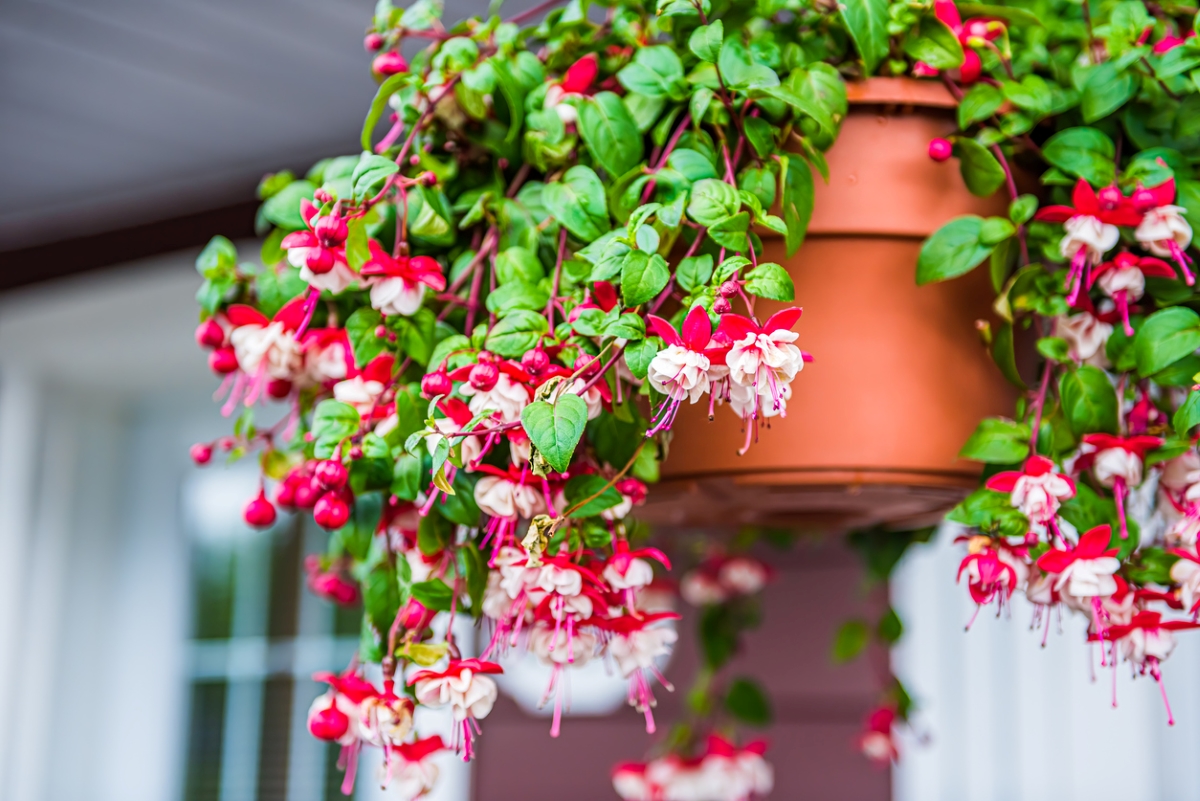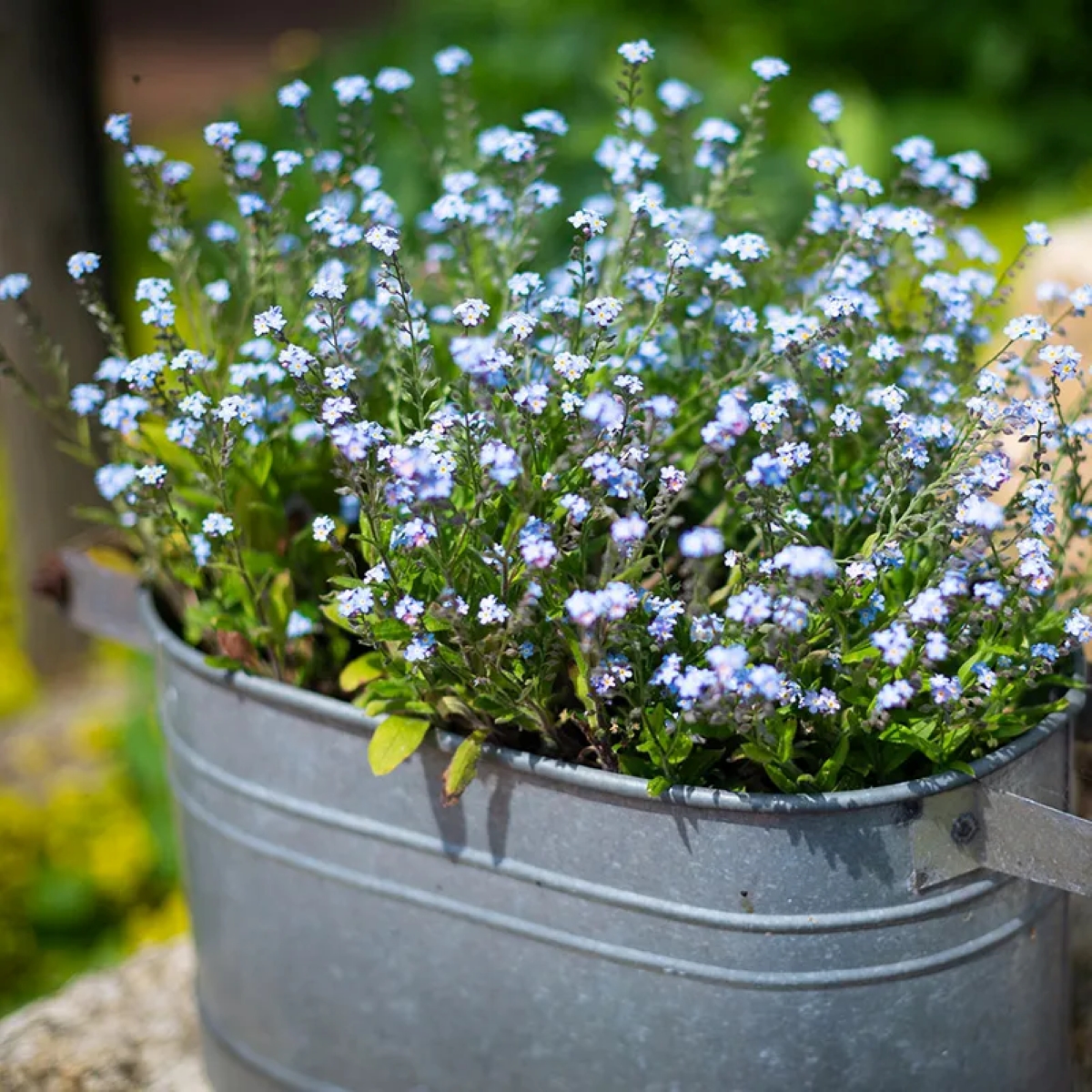We may earn revenue from the products available on this page and participate in affiliate programs. Learn More ›
Brightening a shady spot on your property (and by “shady,” we mean an area that receives less than 6 hours of sunlight per day) with containers full of blooms and greenery is easy once you understand which plants flourish when protected from full sunlight. We recommend starting your shady container garden with annuals since they’re the easiest to grow. After that, you may want to add some perennials to the mix. Here are some shade plants for containers that will brighten your porch, patio, or garden.
RELATED: 22 Fast-Growing Shade Trees to Plant in Your Yard
1. Begonia (Begonia spp.)

Many species in the begonia family are suitable for container gardening, including Rex types, which are grown for their royally striking foliage. Tuberous begonias produce huge, frilly “powder-puff” blooms, and wax types spill forth a profusion of smaller flowers for months. Begonias enjoy rich soil, high humidity, and filtered shade.
2. Caladium (Caladium bicolor)

With color-splashed leaves that are shaped like arrowheads and a height that seldom surpasses 2 feet, caladiums hit the bull’s eye when it comes to brightening shadowy corners. Also called angels’ wings, most caladiums do quite well without direct sun, making them excellent container plants for full shade. Because they thrive in temperatures above 60 degrees Fahrenheit, however, they are better grown in southern climates. Pet owners, take care: Caladium is toxic to both cats and dogs.
3. Coleus (Coleus scutellarioides)

Popular for their “coats of many colors,” coleus cultivars vary in height from 8 inches to 3 feet, and are beloved for their brightly colored leaves. Although they do produce spikes of unobtrusive blue to lavender flowers, the flowers should be pinched out to prevent legginess. Most coleus prefer morning sun and afternoon shade, but sun coleus varieties (like Wizard Velvet Red and Wizard golden) are more tolerant to heat and sunlight.
RELATED: 25 Shade-Loving Plants for Where the Sun Don’t Shine
4. Creeping Jenny (Lysimachia nummularia)

Often sold as a “spiller” for containers, creeping Jenny cascades prettily over the edges of pots—but you’ll want to keep this perennial confined to containers due to its invasive nature. Its yellow-green hue brightens areas with partial shade, as do its 1-inch yellow blooms that appear during the summer.
5. Fern (Dryopteris, Polypodium, etc.)

Just as finely cut green fronds in bouquets provide a lacy backdrop for blooms, ferns in containers can do the same for flowering plants. Woodlands, after all, are ferns’ natural environment, which is why most species can grow in either partial or full shade. Though ferns look stunning hanging in pots, it’s also a good idea to bring them indoors. Some types of fern, such as the Boston fern, remove toxins from the air.
RELATED: Maidenhair Fern Care: How to Master This Humidity-Loving Houseplant
6. Fuchsia (Fuchsia spp.)

Fuchsias come in a variety of sizes and shapes, with single or double, often bi-colored, blooms that sway like pendulous earrings. There are more than 100 species in the genus Fuchsia! Though many gardeners grow these plants as annuals, they’re actually tender perennials that can survive in warm climates—and, with the right care, can be overwintered in colder zones.
Fuchsias do not like humid weather, and will wilt if exposed to direct sunlight or too much heat, making them among the best part shade container plants. They bloom best when provided with moist soil and a little morning sun.
7. Impatiens (Impatiens walleriana)

Impatiens walleriana, also known as busy Lizzie, “busies” itself by producing mounds of colorful blooms in shady places. (The species walleriana is vigorous in partial or full shade and is not to be confused with New Guinea impatiens, which require more sun than their colorful cousins.) Impatiens tend to wilt in dramatic fashion if they dry out, but usually revive quickly from such swoons when provided with a drink of water.
8. Ivy (Hedera spp.)

Often invasive in the landscape, ivies are known for creeping up the sides of centuries-old university buildings. However, they can add “class” to container gardens when shaped into topiary balls or left to cascade over pots’ edges. For a garden that will pass with flying colors, grow ivy in somewhat humid climates—it is prone to spider mites in more arid conditions.
RELATED: Follow This Guide to Ivy Plant Care to Grow Colorful, Contained Vines Indoors
9. Oxalis (Oxalis spp.)

Although plants in this genus are recognized by their showy, shamrock-like foliage, oxalis will keep your containers “in clover” by producing ¾- to 2-inch blooms in white, yellow, pink, or red. Oxalis is usually grown from tubers rather than from seed, and flourishes in partial shade.
10. Pansy (Viola x wittrockiana)

Widely loved for their kittenish faces, pansies like crisp weather and will flourish in spring or fall containers. A partially shaded location, which provides them with the cooler conditions they prefer, should keep them blooming from spring into summer. With blooms that are 2 to 4 inches in diameter and an overall height of 10 inches or so, pansy plants pack a lot of color and character into a compact package. Pinch off faded flowers during that time to prevent the plants from going to seed too soon.
RELATED: The 25 Best Plants for Hanging Baskets
11. Sweet Potato Vine (Ipomoea batatas)

Although related to morning glories, the decorative types of sweet potato vine seldom flower. But their wide variety of cultivars can provide you with almost any color of heart-shaped or lobed leaves you prefer, including black, red, chartreuse, and variegated. Those colors are most intense in full sun, but can also be glorious in partial shade. Though the roots of ornamental sweet potato vine are edible, they’re not so scrumptious.
12. Japanese Maple (Acer palmatum)

Japanese maples are known for their eye-catching ornamental foliage that will treat you to new colors each season, ranging from vibrant red and pink to rich purple. The dwarf cultivars are easiest to grow in containers, but most varieties do well in containers with adequate pruning. These beauties do best with dappled or full shade in the afternoon and a bit of sunlight in the morning.
RELATED: The 20 Best Dwarf Trees for the Front Yard
13. Prayer Plant (Maranta leuconeura)

Prayer plants get their name from their striking leaves, which open flat during the day and fold inward at night. They’re tropical plants that prefer warm temperatures, so keep that in mind if growing a prayer plant in an outdoor container. Whether inside or outside, prayer plants do well in partial to full shade and prefer moist, well-draining soil.
14. Spider Plant (Chlorophytum comosum)

Spider plants feature a rosette of long green leaves, often with white variegation. They grow well in full shade or indirect sunlight, but they grow quickly, so expect to repot them every other year or so. Spider plants are prone to tip burn, which is usually caused by soil that’s too dry or low humidity levels, so keep the soil evenly moist and spray the leaves with water periodically if you live in a low-humidity area.
RELATED: 12 Houseplants That Collect the Most Dust—and Why That’s a Good Thing
15. Wishbone Flower (Torenia fournieri)

Wishbone flowers are low-growing annuals that produce showy, two-toned purple or pink flowers throughout summer and fall. They grow well in containers and make for lovely hanging baskets around a shady deck or pergola. To retain their bushy shape, pinch wishbone flowers back when they start to get leggy.
16. Forget-me-not (Myosotis sylvatica)

Forget-me-nots commonly feature lovely blue flowers, but you can also purchase pink and white cultivars as well. They’re a relatively low-maintenance plant that can do well in full or partial shade, but if you live in a very hot region, they require afternoon shade to thrive and will likely go dormant during the hottest part of the summer.
RELATED: The Best Shade Flowers for Your Low-Light Garden
17. Solomon’s Seal (Polygonatum biflorum)

Featuring hanging clusters of bell-shaped white flowers and bright green foliage, Solomon’s seal is native to eastern North America and grows 1 to 6 feet high, making it among the best tall container plants for shade. It loves partial to full shade, ideally with dappled morning sunlight, but it’s a highly adaptable plant that can do well in a variety of climates. It’s also drought tolerant when well established.
18. Christmas Rose (Helleborus niger)

If you love the idea of winter blooms, then consider planting Christmas rose, which blooms around Christmas in warm areas and in early spring in cooler regions. Resistant to deer grazing, Christmas rose plants prefer partial to full shade and grow to about 1 foot tall, with large, bowl-shaped white flowers that are a great addition to a bouquet or floating in a decorative bowl of water.
RELATED: 17 Deer-Resistant Plants, Flowers, and Shrubs
19. Swedish Ivy (Plectranthus australis)

Swedish ivy is a popular houseplant that can also grow outdoors in zones 10 and 11. This fast-growing, evergreen container plant for shade prefers partial shade, but it can tolerate full shade as well, and it features lavender flowers that will bloom on and off year-round. The frost-tolerant plant should be trimmed regularly to retain its shape and encourage new branches.
20. American Ginseng (Panax quinquefolium)

This little plant usually grows between 12 and 18 inches tall, with compound leaves that form an umbrella-like shape around a central point. In the spring, ginseng will treat you with little white flowers that give way to bright red berries. Well-draining soil and partial to full shade will help this cutie thrive.


